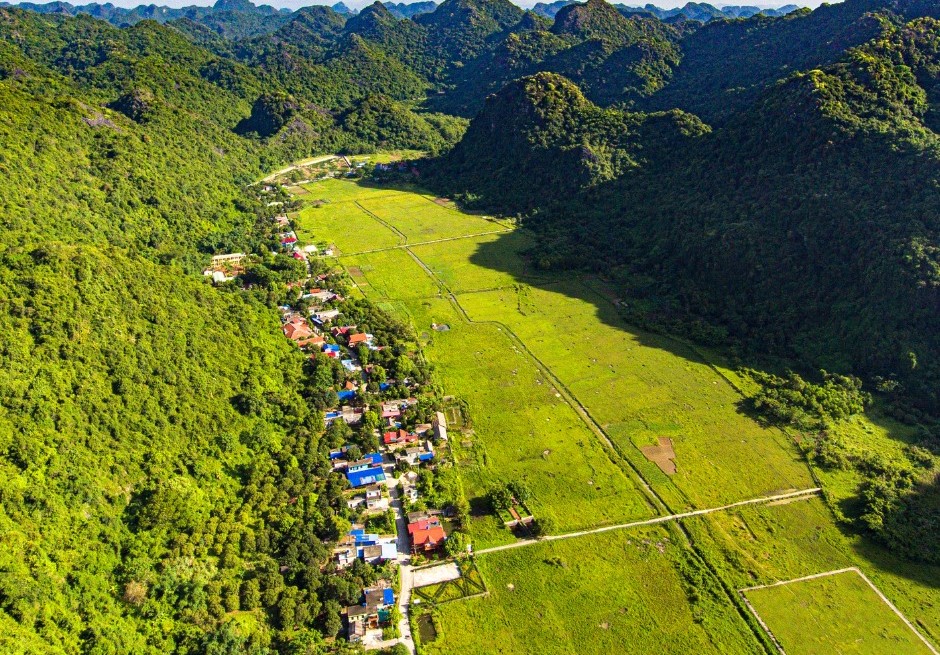VIET HAI VILLAGE
 Location here
Location here
 Viet Hai is one of 12 communes and towns of the island district with an area of 6,817 hectares, with 90 households, a population of about 290 people. To get to Viet Hai, you can choose one of two ways: one is from Beo wharf, visitors take a ferry or hire a tourist boat to take tourists to Lan Ha Bay, about 45 minutes the boat will arrive. Here, visitors can go by motorbike taxi, bicycle or walk to enter the village.
Viet Hai is one of 12 communes and towns of the island district with an area of 6,817 hectares, with 90 households, a population of about 290 people. To get to Viet Hai, you can choose one of two ways: one is from Beo wharf, visitors take a ferry or hire a tourist boat to take tourists to Lan Ha Bay, about 45 minutes the boat will arrive. Here, visitors can go by motorbike taxi, bicycle or walk to enter the village.
 Through three steep mountain slopes, with some places to go under the forest trees, some places to go through cool arch caves, Viet Hai village appears in the middle of the sea, surrounded on all sides by old forests and high limestone mountains. towering like hundreds of green pyramids surrounding the four. For adventurous tourists, you can cross the primeval forest, cross Cat Ba National Park, follow a craggy trail through many steep rocky slopes, caves, and deep ravines to Viet Hai village.
Through three steep mountain slopes, with some places to go under the forest trees, some places to go through cool arch caves, Viet Hai village appears in the middle of the sea, surrounded on all sides by old forests and high limestone mountains. towering like hundreds of green pyramids surrounding the four. For adventurous tourists, you can cross the primeval forest, cross Cat Ba National Park, follow a craggy trail through many steep rocky slopes, caves, and deep ravines to Viet Hai village.

 1. The administrative process of establishing Viet Hai commune
1. The administrative process of establishing Viet Hai commune
In the mid-18th century, Nguyen Huu Cau (ie District He) waged an uprising against the Le-Trinh court, Cat Ba archipelago and Viet Hai area with rugged mountains and forests chosen by the insurgent army as a logistics base.
 In the years 1885-1889, the uprising led by Doc Tit and Tien Duc against the French army chose Cat Ba as an important base. The insurgents relied on the difficult terrain of Trung Trang, Mai Go, Tra Bau and Viet Hai to fight. The forces of Doc Tit (in Trai Son, Thuy Nguyen) and Tien Duc in Cat Ba coordinated to conduct major battles. In 1889, a big battle broke out between the resistance insurgents and the French colonialists. Due to the disparity of forces between the two sides, the leader of the Tien Duc insurgent army withdrew to Viet Hai area, then left Cat Ba.
In the years 1885-1889, the uprising led by Doc Tit and Tien Duc against the French army chose Cat Ba as an important base. The insurgents relied on the difficult terrain of Trung Trang, Mai Go, Tra Bau and Viet Hai to fight. The forces of Doc Tit (in Trai Son, Thuy Nguyen) and Tien Duc in Cat Ba coordinated to conduct major battles. In 1889, a big battle broke out between the resistance insurgents and the French colonialists. Due to the disparity of forces between the two sides, the leader of the Tien Duc insurgent army withdrew to Viet Hai area, then left Cat Ba.
 In November 1949, the Resistance Committee of Ha Cat district sent forces to Tra Bau to announce the decision to establish Viet Hung commune, including Tra Bau and Tai Lai villages, to establish the commune government and other organizations in the commune. In 1959, the Vietnamese government decided to establish Viet Hai commune (from the former Viet Hung commune). In the 1960s, Minh Tan Cooperative was established, Viet Hai commune, consisting of 4 production teams, including: 2 teams in Tai Lai village, 1 team in Ang Vong, 1 team in Tra Bau.
In November 1949, the Resistance Committee of Ha Cat district sent forces to Tra Bau to announce the decision to establish Viet Hung commune, including Tra Bau and Tai Lai villages, to establish the commune government and other organizations in the commune. In 1959, the Vietnamese government decided to establish Viet Hai commune (from the former Viet Hung commune). In the 1960s, Minh Tan Cooperative was established, Viet Hai commune, consisting of 4 production teams, including: 2 teams in Tai Lai village, 1 team in Ang Vong, 1 team in Tra Bau.



 2. The process of forming a residential community in Viet Hai commune
2. The process of forming a residential community in Viet Hai commune
Around the 1930s, there were two Chinese people, Ly Gia Nhan and Mac Tac Kham from Hoanh Bo, Quang Ninh, along with 10 tenants (who were employed in agriculture in the past) to exploit the vast forests into fields in Tai Lai, Ninh Tiep and Ang Vong. Later, the tenants married and became households in Tai Lai village.
 Residents of Tai Lai village live mainly by farming, grazing cattle and poultry, and exploiting products from the forest and sea. In these years, the population lived scatteredly in Ang Vong, Ang Ca, Tra Bau but concentrated in Tai Lai valley more. Tai Lai is the largest valley (a residential area in Viet Hai commune today) with a length of about 1.3 km, the average width of the valley is about 300m. At this time, Tai Lai village has 12 households, Tra Bau has 3 households, Ang Vong has 1 household. In the area of Co Do cave (today's east of Hai Son village), there are a number of fishing families who have settled in Tai Lai village.
Residents of Tai Lai village live mainly by farming, grazing cattle and poultry, and exploiting products from the forest and sea. In these years, the population lived scatteredly in Ang Vong, Ang Ca, Tra Bau but concentrated in Tai Lai valley more. Tai Lai is the largest valley (a residential area in Viet Hai commune today) with a length of about 1.3 km, the average width of the valley is about 300m. At this time, Tai Lai village has 12 households, Tra Bau has 3 households, Ang Vong has 1 household. In the area of Co Do cave (today's east of Hai Son village), there are a number of fishing families who have settled in Tai Lai village.
 The life of the residents in the ancient Viet Hai was very difficult, self-sufficiency was the main thing.
The life of the residents in the ancient Viet Hai was very difficult, self-sufficiency was the main thing.

 Towards the end of 1947, some Chinese families in Tai Lai, Tra Bau told each other that where they were living, bad omens often occurred, and bad things had left their homes on Cat Ba Street. At that time, the French soldiers who were managing Cat Ba Street forced these Chinese to return to Hoang Bo, Quang Ninh.
Towards the end of 1947, some Chinese families in Tai Lai, Tra Bau told each other that where they were living, bad omens often occurred, and bad things had left their homes on Cat Ba Street. At that time, the French soldiers who were managing Cat Ba Street forced these Chinese to return to Hoang Bo, Quang Ninh.
 The Chinese left Tai Lai, leaving their house and two plowing buffaloes. In Tai Lai village, there are only 02 Vietnamese families left. By the beginning of 1948, all the Chinese in Tai Lai and Tra Jewel had moved away. Nearly 10 households from their hometown in Hai Duong, Hoang Chau commune (Cat Hai district), Pha Le commune (Thuy Nguyen district) living in Cai Minh Tu have moved to Tai Lai village to live.
The Chinese left Tai Lai, leaving their house and two plowing buffaloes. In Tai Lai village, there are only 02 Vietnamese families left. By the beginning of 1948, all the Chinese in Tai Lai and Tra Jewel had moved away. Nearly 10 households from their hometown in Hai Duong, Hoang Chau commune (Cat Hai district), Pha Le commune (Thuy Nguyen district) living in Cai Minh Tu have moved to Tai Lai village to live.
 In 1950, after the Chinese left Tai Lai and Tra Bau, the Resistance Committee mobilized the people in Ha Sen base communes and Ha Village on Cat Ba island to live in Tai Lai, gradually Tai Lai village. in the 50s of the last century there were about 30 households. Also in these years, 4 households relocated from Ha Nam and Gia Luan to Tai Lai village. The Resistance Committee established the Kinh Tai Finance Committee to guide the people to receive the property left by the Chinese, and at the same time focus on developing production.
In 1950, after the Chinese left Tai Lai and Tra Bau, the Resistance Committee mobilized the people in Ha Sen base communes and Ha Village on Cat Ba island to live in Tai Lai, gradually Tai Lai village. in the 50s of the last century there were about 30 households. Also in these years, 4 households relocated from Ha Nam and Gia Luan to Tai Lai village. The Resistance Committee established the Kinh Tai Finance Committee to guide the people to receive the property left by the Chinese, and at the same time focus on developing production.
 In the 1950s, two groups of people moved to Viet Hung, including: Head of the village Nguyen Dinh Chien with his family in Phu Long commune and a number of households in the same family in Hon Gai (in Ha Long city, Quang Ninh province today); Tan Lap group led by Mr. Tran Van Me as the leader from Tranh Giang, Quang Yen, evacuated to Lan Ha Bay area to avoid bombs and bullets, so the number of families in Viet Hung commune at this time was about 44 households with 200 people.
In the 1950s, two groups of people moved to Viet Hung, including: Head of the village Nguyen Dinh Chien with his family in Phu Long commune and a number of households in the same family in Hon Gai (in Ha Long city, Quang Ninh province today); Tan Lap group led by Mr. Tran Van Me as the leader from Tranh Giang, Quang Yen, evacuated to Lan Ha Bay area to avoid bombs and bullets, so the number of families in Viet Hung commune at this time was about 44 households with 200 people.
 After being devastated by the war, the people in Viet Hung commune were scattered, the village head Nguyen Dinh Chien brought his family and the family moved to Ang Dai, Phu Long commune. The Tan Lap group moved to Ang Ha Bay (which is today's Viet Hai wharf), taking the name Co Do village.
After being devastated by the war, the people in Viet Hung commune were scattered, the village head Nguyen Dinh Chien brought his family and the family moved to Ang Dai, Phu Long commune. The Tan Lap group moved to Ang Ha Bay (which is today's Viet Hai wharf), taking the name Co Do village.
 After the 1954 Geneva Agreement, to restore peace in Indochina, Tan Lap village in Viet Hai Ben moved to live in Lan Ha Bay, established Hai Dong fishing delegation, administratively still under the management of the Management Tai Lai village, Viet Hung commune (now Viet Hai commune).
After the 1954 Geneva Agreement, to restore peace in Indochina, Tan Lap village in Viet Hai Ben moved to live in Lan Ha Bay, established Hai Dong fishing delegation, administratively still under the management of the Management Tai Lai village, Viet Hung commune (now Viet Hai commune).
 In November 1963, according to the policy of Hai Phong City and Cat Ba District, Viet Hai Commune received about 20 households moving to the island to build a new economy from Trang Cat Commune (now Trang Cat Ward, Hai An District). These households are part of the population of present-day Viet Hai commune.
In November 1963, according to the policy of Hai Phong City and Cat Ba District, Viet Hai Commune received about 20 households moving to the island to build a new economy from Trang Cat Commune (now Trang Cat Ward, Hai An District). These households are part of the population of present-day Viet Hai commune.


